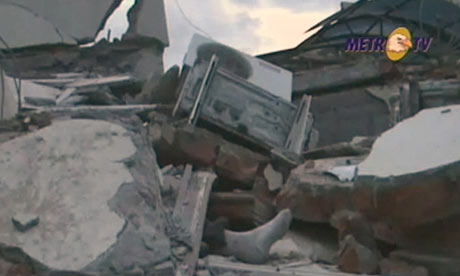Second earthquake hits stricken Sumatra
• Second earthquake has shaken western Indonesia as hundreds remain trapped
• Quake struck about 180 miles from epicentre of first tremors
- guardian.co.uk, Thursday 1 October 2009 05.52 BST
- Article history

A video grab shows a foot among the wreckage of a building following an earthquake in Padang in Indonesia Photograph: REUTERS TV/Reuters
A second powerful earthquake has hit the Indonesian island of Sumatra, a day after the first devastating quake which has left hundreds and possibly thousands of people buried in rubble and a major city cut off from the outside world.
The new quake, of 6.9 magnitude, struck in the early hours, about 180 miles from the epicentre of the more powerful tremor out at sea yesterday - becoming the second large quake to hit the area within 24 hours.
The number of confirmed deaths from the first quake was between 100 and 200, according to disaster relief officials but they warned that the figure was likely to rise, with the head of the country's crisis centre saying at least 1,000 may have been killed.
There were no immediate injuries known from the second quake.
Indonesia's government dispatched teams of rescue workers to the stricken region. International aid agencies were preparing to launch a major relief effort as tens of thousands of people spent a night in the open in pouring rain after their homes were damaged.
Health minister Siti Fadilah Supari said: "This is a high-scale disaster," adding that he believed it was more powerful than the earthquake in Yogyakarta in 2006, referring to a city on the Indonesian island of Java where 3,000 people died.
The magnitude 7.6 earthquake – which came less than 24 hours after another fatal quake off the South Pacific island of Samoa – struck at 5.16pm. Its centre was reported to be around 30 miles offshore from Padang, a city of 900,000, at a depth of around 53 miles.
There was immediate widespread panic in the city. "The earthquake was very strong," said a woman called Kasmiati, who lives on the coast. "People ran to high ground. Houses and buildings were badly damaged. I was outside, so I am safe, but my children at home were injured," she said before her mobile phone went dead.
Fears that a catastrophe might have occurred were raised after Indonesia's vice-president, Jusuf Kalla, told a news conference in Jakarta that homes, hotels, mosques, schools, shops and other buildings had been destroyed in Padang, the largest city in western Sumatra.
Television footage from the city showed scenes of devastation, including the foot of a buried body sticking from rubble.
"We have received a report from the mayor of Padang that the death toll is 75. But many others are trapped in collapsed shops, building and hotels." Kalla added: "It is definitely higher than that. It's hard to tell because there is heavy rain and a blackout."
Officials with Indonesia's National Search and Rescue Agency, who were attempting to reach the scene last night, said they had also received reports that many homes had been destroyed, with early reports suggesting that between 500 and 1,000 houses had collapsed.
Priyadi Kardono, a spokesman for Indonesia's National Disaster Management Agency, said it had also received eyewitness accounts of destruction in the nearby town of Pariaman, to the north of Padang, as well as in Padang itself. Fears that the death toll could rise rapidly were raised by Rustam Pakaya, head of the health ministry's crisis centre, who said that in addition to known fatalities, thousands more people could be buried in the rubble, though officials later suggested the number still trapped in the city was as low as 100. Two hospitals in Padang were reported to be among the collapsed buildings, said Rustum, adding that a field hospital was being prepared to help survivors. Several hotels were also said to have been seriously damaged, while a shopping mall was badly hit.
The first emergency medical relief – a team of 40 doctors from Jakarta – was expected to reach the area today.
Rescue efforts, however, have been hampered by the disruption of electricity and telecommunication lines, which have thrown Padang into darkness. All roads into the city were also reported to have been blocked by landslides.
In a further blow the airport at Padang was described as "inaccessible" by a pilot from the state airline who attempted to reach it and was forced to turn back. According to one report the roof of the airport had caved in.
While most of the early attention has focused on the large, sprawling city of Padang, concern was mounting over the fate of towns and villages in the surrounding countryside. In the town of Maninjau, further inland, a resident, Hafiz, told local media he had watched houses being buried in a landslide when a hill collapsed.
The earthquake in Sumatra came 24 hours after a huge tsunami struck Samoa at dawn on Tuesday – triggered by an earthquake measuring between 8.0 and 8.3 – which also flattened villages and swept cars and people out to sea, killing at least 100 people and leaving dozens missing. Survivors fled the churning water for higher ground on the South Pacific islands.
Shocks from the Sumatran earthquake could be felt in high buildings in Jakarta, several hundred miles away. It was also felt in neighbouring Singapore and Malaysia.
An eyewitness to the destruction in Sumatra was Malaysian student Fashareena Nazir, who is studying at the Universitas Andalas medical faculty, which was damaged in the earthquake.
"There were rumbles and a loud noise, like a bang," she told Malaysia's Bernama news agency after walking three miles to safety. The 23-year old described seeing neighbours' houses on fire and ground caving in or disappearing before her eyes.
Another severely damaged location was reported to be Padang's Industrial Technic Academy. A lecturer there, Erwinsyah Sipahutar, told local television that hundreds of students evacuated the campus as the quake broke most of the windows.
"We were shaken like matchsticks," Erwinsyah said.
Another resident of Padang, called Adi, later told Metro Television there was devastation all around him. "For now I can't see dead bodies, just collapsed houses. Some half-destroyed, others completely. People are standing around too scared to go back inside. They fear a tsunami," said Adi. "No help has arrived yet. I can see small children standing around carrying blankets. Some people are looking for relatives but all the lights have gone out completely."
In Pariaman – closer to the centre – one resident, Yuliarni, told TV One news: "The shaking was the worst I had ever felt. Houses have collapsed, the lights and electricity were cut off … People were fleeing to higher ground and some were hurt."
Padang lies on one of the world's most active faultlines, where the Indo-Australian and Eurasian plates are colliding, and had been named by geologists in Indonesia as the most likely location to fall victim to a major earthquake or tsunami. It is the same faultline that was responsible for the devastating Indian Ocean tsunami that killed more than 220,000 people on Boxing Day 2004.
The zone's other segments have already cracked, including a large portion off Aceh, at the northern tip of Sumatra, which triggered the 2004 tsunami.
"Padang sits right in front of the area with the greatest potential for an 8.9 magnitude earthquake," Danny Hilman Natawidjaja, a geologist at the Indonesian Science Institute, warned in February. "The entire city could drown" in a tsunami triggered by such a quake, he warned then.
Backpackers' gateway
Padang is a sprawling city of 900,000 residents on the west coast of Sumatra. Described as friendly, noisy, bustling and dirty, Padang is a popular jumping-off point for backpackers and surfers hoping to reach the Indian Ocean islands of Mentawai, the hills and national parks beyond the city, and other destinations in Indonesia and Malaysia. The city itself has few attractions besides Taplau beach, with its beautiful sunsets and hundreds of food stalls, and Bungus bay, popular with swimmers and locals in the evenings.
Arriving from the relative comfort of the mainland makes for a rough landing, writes the Lonely Planet. "Despite the urge to hide from the smell of kerosene and diesel exhaust, you'll find that the locals are genuinely friendly and curious about the few foreigners who find their way into town … a sprawling, noisy place circumnavigated by tripped-out opelet [minibus] blasting squeaks-and-beeps techno music."
Jo Adetunji
(Source: guardian.co.uk)

1 comment:
This is a horrible tragedy - two such catastrophic earthquakes striking almost one after another! I really feel sorry for the victims and for those who lost their loved ones, but still, in situations like these, I always feel moved when I hear about people helping each other, despite they are complete strangers. It makes me wish I could do something more from here...
Post a Comment